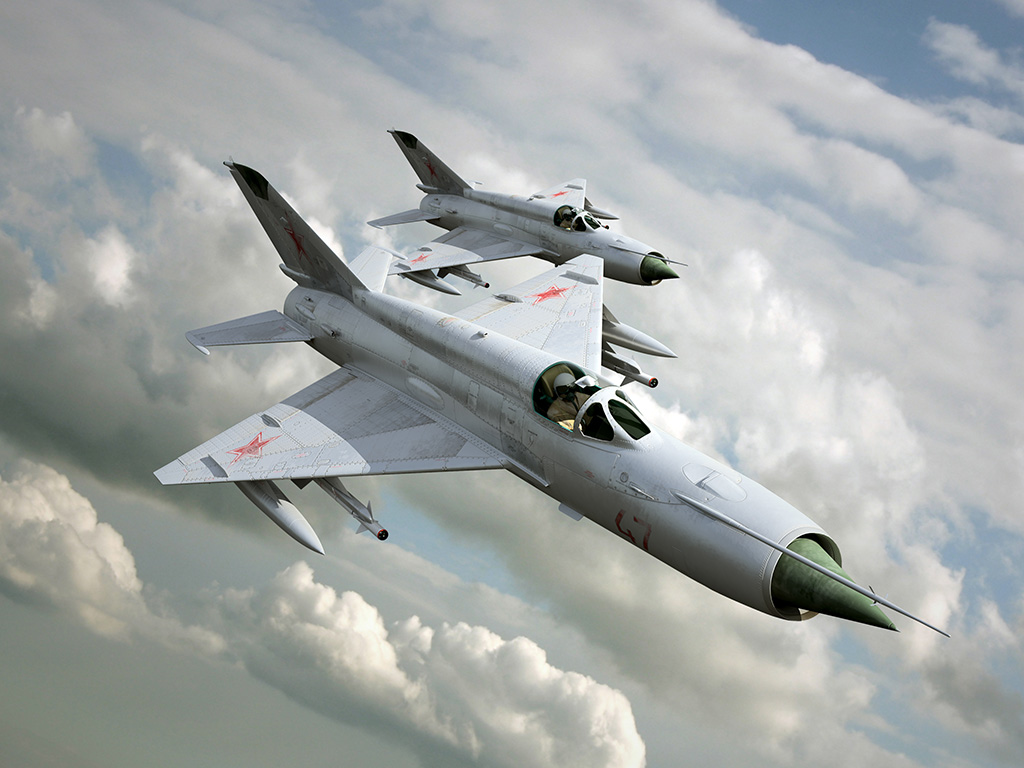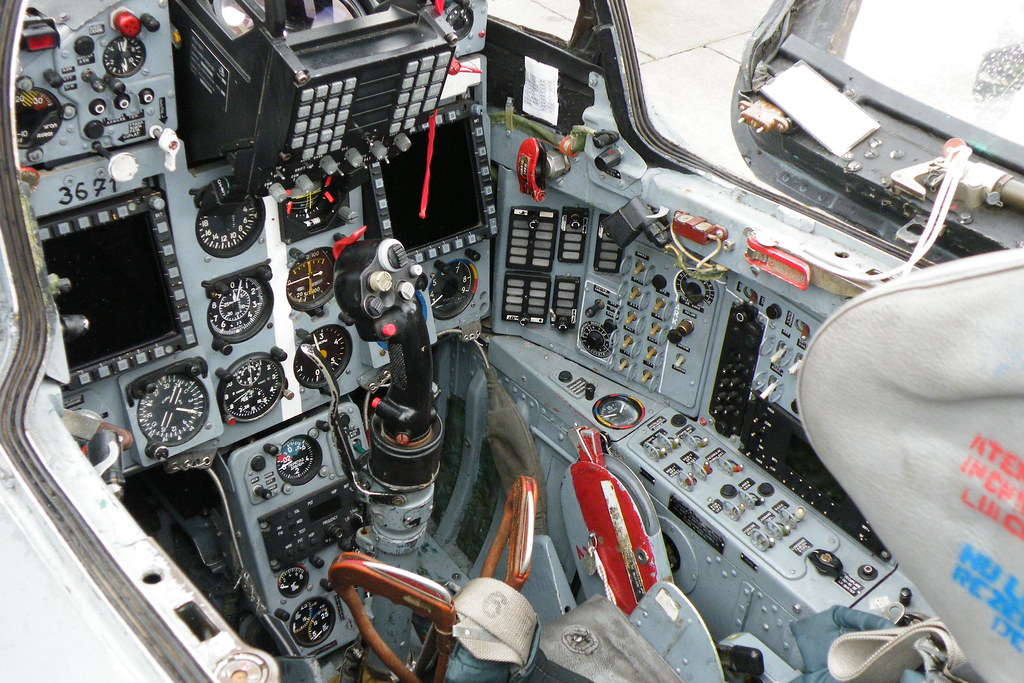Could Russia's Cold War Super-Jet Last 100 Years?
Military aircraft can have notoriously short lifespans, especially during periods of technological ferment. The most elite aircraft of World War I could become obsolete in a matter of months. Things weren’t much different in World War II. And at the dawn of the jet age, entire fleets of aircraft became passé as technologies matured. The advanced fighters that fought in the skies over Korea became junk just a few years later.
But a few designs stand the test of the time. The B-52 Stratofortress first flew in 1952, yet remains in service today. New C-130s continue to roll off the production line, based on a design that became operational in 1954.
But those are bombers and transport aircraft; they don’t fight one another. Fighters face a special problem of longevity, because they must compete directly with newer models. Thus, very few fighters have had long lifespans, either in production or in service.
The MiG-21 “Fishbed” is an exception.
Origins
Initial suitability studies for the MiG-21 began in 1953. The success of the MiG-15 and MiG-17 suggested that Soviet aerospace engineers could compete with their Western counterparts, and with the MiG-19 the Soviets had their first supersonic fighter. However, technology changed so quickly in the first two decades of jet flight that the fighters that had dominated the Korean War were effectively obsolete by the mid-1950s. MiG-15s could cut apart a formation of B-29s, but couldn’t even catch modern American bombers. The Soviets intended the MiG-21 to change that, while also providing an effective air superiority option.
The MiG-21 (eventually dubbed “Fishbed” by NATO) would exceed Mach 2.0, with an internal cannon and the capacity to carry between two and six missiles (the Fishbed actually preceded the missiles into service). Like most fighters the MiG-21 would eventually serve in a ground attack role, in which it can carry a limited number of bombs and rockets. As with many of their fighters, the Soviets preferred to operate the MiG-21 from ground control, eliminating the need for bulky, sophisticated radar equipment.
Altogether, the USSR would build 10,645 Fishbeds between 1959 and 1985. India would construct another 657 under a licensing and technology transfer agreement with Moscow, while Czechoslovakia built 194 under license. Under complicated and somewhat dubious circumstances, the People’s Republic of China acquired sufficient aircraft and technical documents to reverse engineer the MiG-21 into the Chengdu J-7/F-7. China produced around 2,400 Fishbeds between 1966 and 2013. The combined numbers make the Fishbed by far the most produced supersonic aircraft in world history.
Longevity
With the MiG-21, engineers sorted through a set of basic problems that future research could not substantially improve upon. Modern fighters don’t fly much faster than the MiG-21, or maneuver much more capably. While they do carry more ordnance and have more sophisticated electronic equipment, many air forces can treat these as luxuries; they simply want a cheap, fast, easy-to-maintain aircraft that can patrol airspace and occasionally drop a few bombs. The Fishbed fits the bill.
To be sure, the Fishbed would not have been a particularly useful fighter in Western service. It has short legs, cannot carry a great deal of ordnance and lacks the space for sophisticated electronic equipment. The shape of its cockpit limits pilot awareness. However, it aptly fulfilled the Soviet need for a ground control intercept fighter that could fly and fight over the battlefields of Western Europe, as well as act in a limited interceptor role.
During the Cold War, the United States came into possession of a number of MiG-21 variants (eventually purchasing a squadron of J-7s from China). Generally speaking, American pilots spoke well of the plane, and it performed more than adequately in aggressor training situations.
The Fishbed at War
The MiG-21 never saw combat on the Central Front in a NATO-Warsaw Pact war, but it certainly has seen its share of action.
In Vietnam, pencil-thin MiG-21s found that they could take advantage of American rules of engagement by using their size and speed to cut through bomber packages before U.S. fighters could visually identify and target them. The size and maneuverability of the Fishbed also allowed them to evade early air-to-air missiles. After attacking, the MiGs would run for home.
One exception to this pattern came on January 2, 1967, when a group of F-4 Phantom IIs under the command of legendary pilot Robin Olds tricked North Vietnamese commanders into a disastrous engagement. The Phantoms shot down seven Fishbeds that day, including one flown by Nguyen Van Coc, who would survive the crash and accumulate nine kills over the rest of the war. This would mark Nguyen as the most successful Fishbed pilot of all time, although several other Vietnamese and several Syrian pilots would achieve ace distinction while flying the MiG-21.
The MiG-21 saw extensive service in wars across the Middle East. The fighter-bombers of the Israeli Defense Force devastated Egyptian and Syrian Fishbeds in the opening strikes of the Six-Day War. Fishbeds fought Israeli fighters in the War of Attrition, the Yom Kippur War and the Lebanon War, generally suffering badly at the hands of outstanding Israeli pilots.
Military aircraft can have notoriously short lifespans, especially during periods of technological ferment. The most elite aircraft of World War I could become obsolete in a matter of months. Things weren’t much different in World War II. And at the dawn of the jet age, entire fleets of aircraft became passé as technologies matured. The advanced fighters that fought in the skies over Korea became junk just a few years later.
But a few designs stand the test of the time. The B-52 Stratofortress first flew in 1952, yet remains in service today. New C-130s continue to roll off the production line, based on a design that became operational in 1954.
But those are bombers and transport aircraft; they don’t fight one another. Fighters face a special problem of longevity, because they must compete directly with newer models. Thus, very few fighters have had long lifespans, either in production or in service.
The MiG-21 “Fishbed” is an exception.
Origins
Initial suitability studies for the MiG-21 began in 1953. The success of the MiG-15 and MiG-17 suggested that Soviet aerospace engineers could compete with their Western counterparts, and with the MiG-19 the Soviets had their first supersonic fighter. However, technology changed so quickly in the first two decades of jet flight that the fighters that had dominated the Korean War were effectively obsolete by the mid-1950s. MiG-15s could cut apart a formation of B-29s, but couldn’t even catch modern American bombers. The Soviets intended the MiG-21 to change that, while also providing an effective air superiority option.
The MiG-21 (eventually dubbed “Fishbed” by NATO) would exceed Mach 2.0, with an internal cannon and the capacity to carry between two and six missiles (the Fishbed actually preceded the missiles into service). Like most fighters the MiG-21 would eventually serve in a ground attack role, in which it can carry a limited number of bombs and rockets. As with many of their fighters, the Soviets preferred to operate the MiG-21 from ground control, eliminating the need for bulky, sophisticated radar equipment.
Altogether, the USSR would build 10,645 Fishbeds between 1959 and 1985. India would construct another 657 under a licensing and technology transfer agreement with Moscow, while Czechoslovakia built 194 under license. Under complicated and somewhat dubious circumstances, the People’s Republic of China acquired sufficient aircraft and technical documents to reverse engineer the MiG-21 into the Chengdu J-7/F-7. China produced around 2,400 Fishbeds between 1966 and 2013. The combined numbers make the Fishbed by far the most produced supersonic aircraft in world history.
Longevity
With the MiG-21, engineers sorted through a set of basic problems that future research could not substantially improve upon. Modern fighters don’t fly much faster than the MiG-21, or maneuver much more capably. While they do carry more ordnance and have more sophisticated electronic equipment, many air forces can treat these as luxuries; they simply want a cheap, fast, easy-to-maintain aircraft that can patrol airspace and occasionally drop a few bombs. The Fishbed fits the bill.
To be sure, the Fishbed would not have been a particularly useful fighter in Western service. It has short legs, cannot carry a great deal of ordnance and lacks the space for sophisticated electronic equipment. The shape of its cockpit limits pilot awareness. However, it aptly fulfilled the Soviet need for a ground control intercept fighter that could fly and fight over the battlefields of Western Europe, as well as act in a limited interceptor role.
During the Cold War, the United States came into possession of a number of MiG-21 variants (eventually purchasing a squadron of J-7s from China). Generally speaking, American pilots spoke well of the plane, and it performed more than adequately in aggressor training situations. Indeed, highly trained American pilots probably pushed the MiG-21 farther than most Soviet pilots could have done.
The Fishbed at War
The MiG-21 never saw combat on the Central Front in a NATO-Warsaw Pact war, but it certainly has seen its share of action.
In Vietnam, pencil-thin MiG-21s found that they could take advantage of American rules of engagement by using their size and speed to cut through bomber packages before U.S. fighters could visually identify and target them. The size and maneuverability of the Fishbed also allowed them to evade early air-to-air missiles. After attacking, the MiGs would run for home.
One exception to this pattern came on January 2, 1967, when a group of F-4 Phantom IIs under the command of legendary pilot Robin Olds tricked North Vietnamese commanders into a disastrous engagement. The Phantoms shot down seven Fishbeds that day, including one flown by Nguyen Van Coc, who would survive the crash and accumulate nine kills over the rest of the war. This would mark Nguyen as the most successful Fishbed pilot of all time, although several other Vietnamese and several Syrian pilots would achieve ace distinction while flying the MiG-21.
The MiG-21 saw extensive service in wars across the Middle East. The fighter-bombers of the Israeli Defense Force devastated Egyptian and Syrian Fishbeds in the opening strikes of the Six-Day War. Fishbeds fought Israeli fighters in the War of Attrition, the Yom Kippur War and the Lebanon War, generally suffering badly at the hands of outstanding Israeli pilots. In one case, Israeli fighters ambushed and destroyed several MiG-21s flown by Soviet pilots.
fontelink
User Tag List
Risultati da 1 a 5 di 5
Discussione: Mig-21: Il compagno caccia è immortale
-
20-08-16, 09:54 #1Сардиния

- Data Registrazione
- 12 Nov 2009
- Località
- Терранова
- Messaggi
- 7,133
-

- 2,344
-

- 3,090
- Mentioned
- 62 Post(s)
- Tagged
- 1 Thread(s)
 Mig-21: Il compagno caccia è immortale
Mig-21: Il compagno caccia è immortale
-
20-08-16, 09:57 #2Сардиния

- Data Registrazione
- 12 Nov 2009
- Località
- Терранова
- Messaggi
- 7,133
-

- 2,344
-

- 3,090
- Mentioned
- 62 Post(s)
- Tagged
- 1 Thread(s)
 Re: Mig-21: Il compagno caccia è immortale
Re: Mig-21: Il compagno caccia è immortale

-
20-08-16, 10:06 #3Сардиния

- Data Registrazione
- 12 Nov 2009
- Località
- Терранова
- Messaggi
- 7,133
-

- 2,344
-

- 3,090
- Mentioned
- 62 Post(s)
- Tagged
- 1 Thread(s)
 Re: Mig-21: Il compagno caccia è immortale
Re: Mig-21: Il compagno caccia è immortale







-
20-08-16, 10:13 #4Сардиния

- Data Registrazione
- 12 Nov 2009
- Località
- Терранова
- Messaggi
- 7,133
-

- 2,344
-

- 3,090
- Mentioned
- 62 Post(s)
- Tagged
- 1 Thread(s)
 Re: Mig-21: Il compagno caccia è immortale
Re: Mig-21: Il compagno caccia è immortale
-
20-08-16, 10:17 #5Сардиния

- Data Registrazione
- 12 Nov 2009
- Località
- Терранова
- Messaggi
- 7,133
-

- 2,344
-

- 3,090
- Mentioned
- 62 Post(s)
- Tagged
- 1 Thread(s)
 Re: Mig-21: Il compagno caccia è immortale
Re: Mig-21: Il compagno caccia è immortale

Discussioni Simili
-
Anche l'Unità caccia il compagno Fini.
Di mustang nel forum Centrodestra ItalianoRisposte: 0Ultimo Messaggio: 31-08-10, 09:58 -
Il compagno Fassino al compagno Mantino: HAI ROTTO I COGLIONI!!!
Di Tizius MCMLXVI nel forum Politica NazionaleRisposte: 0Ultimo Messaggio: 10-01-09, 11:06 -
Fondoschiena maschile cercasi: il "volto" di Roberta è a caccia di un compagno
Di FdV77 nel forum FondoscalaRisposte: 28Ultimo Messaggio: 26-09-06, 01:26 -
"Occhio di lince" Cheney ha impallinato un compagno di caccia
Di bluedanube nel forum Politica EsteraRisposte: 36Ultimo Messaggio: 16-02-06, 23:25 -
B-52 l'immortale
Di Nickel01 nel forum Tecnologia militareRisposte: 4Ultimo Messaggio: 08-08-05, 11:20





 Rispondi Citando
Rispondi Citando